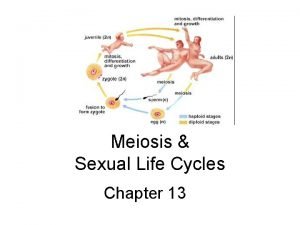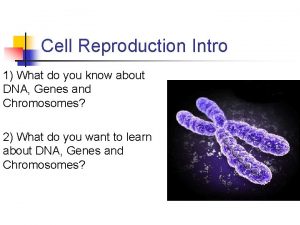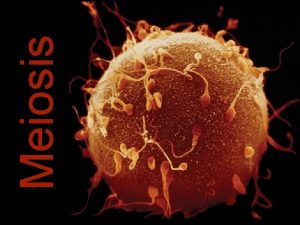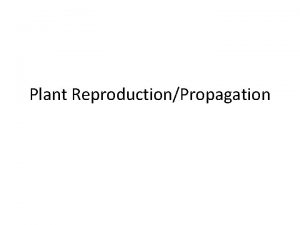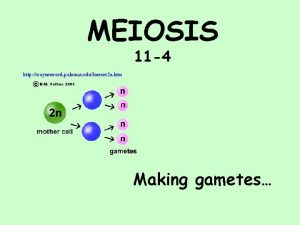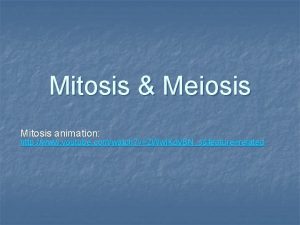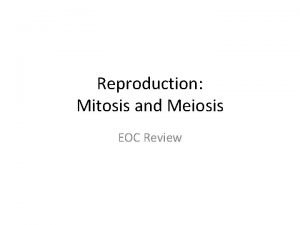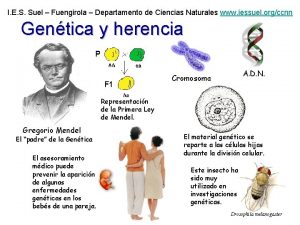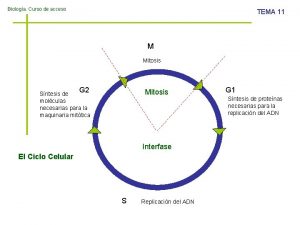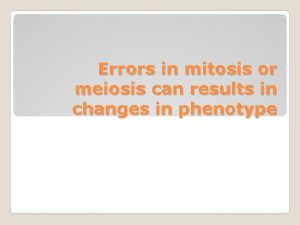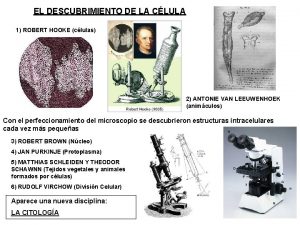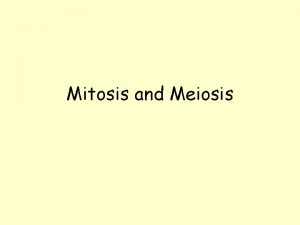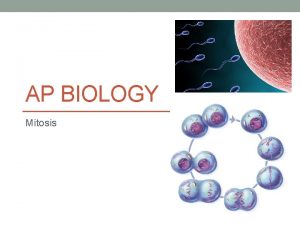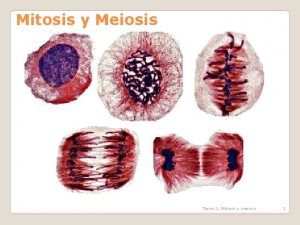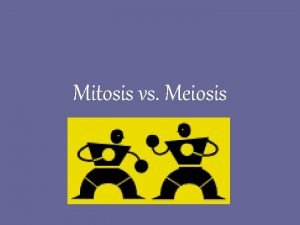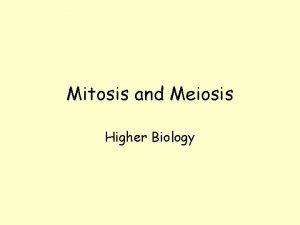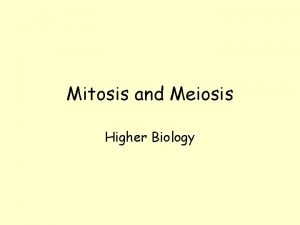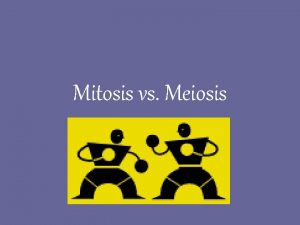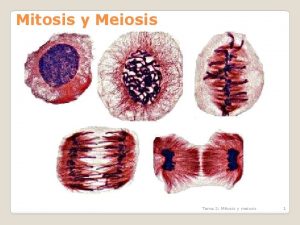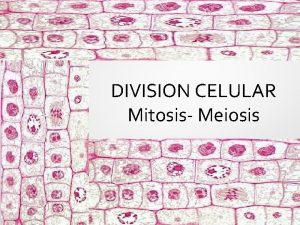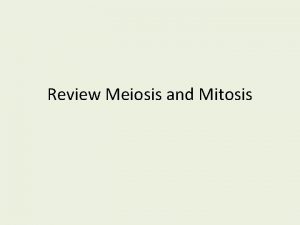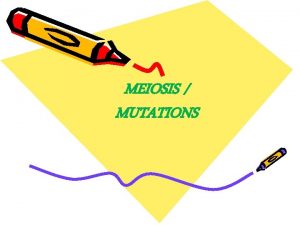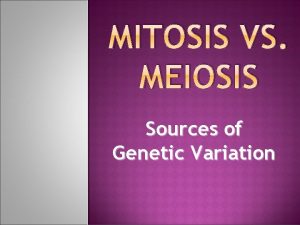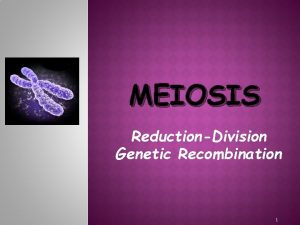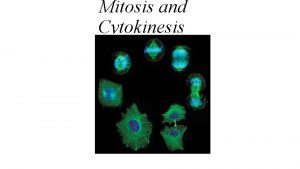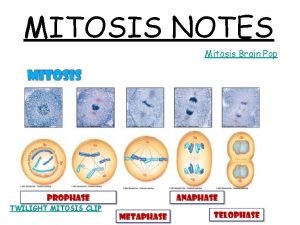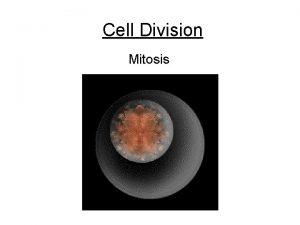Meiosis 1 10 17 Mitosis Genetic constancy via






















- Slides: 22

Meiosis 1. 10. 17

Mitosis • Genetic constancy via replication vs. Meiosis • Genetic diversity via recombination (shuffling) • How many outfits can be made from 5 pairs of pants and 5 shirts?

Mitosis • Genetic constancy via replication vs. Meiosis • Genetic diversity via recombination (shuffling) • How many outfits can be made from 5 pairs of pants and 5 shirts? • 5 x 5 = 25 possibilities • (Imagine the # of possibilities with 25, 000+ genes!)

Meiosis • The process of cell division that reduces the chromosome # by ½

Meiosis • The process of cell division that reduces the chromosome # by ½ • Only used in sexual reproduction (not in bacteria or other asexual reproducers)

Meiosis • The process of cell division that reduces the chromosome # by ½ • Only used in sexual reproduction (not in bacteria or other asexual reproducers) • In humans: – 46 chromosomes in somatic (body) cells -> 23 chromosomes in gametes (sex cells) – 2 n -> 1 n (diploid -> haploid)

Why Sexual Reproduction?

Why Sexual Reproduction? • Why not?

Why Sexual Reproduction? • Why not? – Only ½ of population reproduces – less potential offspring – Huge energy expenditure in offspring production – Only get to pass on ½ of your genome

Why Sexual Reproduction? • Why not? – Only ½ of population reproduces – less potential offspring – Huge energy expenditure in offspring production – Only get to pass on ½ of your genome • Why?

Why Sexual Reproduction? • Why not? – Only ½ of population reproduces – less potential offspring – Huge energy expenditure in offspring production – Only get to pass on ½ of your genome • Why? – MUCH more variation (genetic diversity) – The variation provides the raw material for change, allowing species to survive changing conditions

Mitosis vs. Meiosis Mitosis Phase Meiosis • Cell grows G 1 • DNA Replication S • DNA Replication • Cell prepares for division G 2 • Cell prepares for division • Cell grows

Mitosis vs. Meiosis Mitosis • Chromosomes condense Phase • Prophase I crossing over occurs! • Individual chromosomes line up across middle of the cell • Metaphase I Meiosis • Chromosomes condense and pair with homologue to form a tetrad • Homologous chromosome pairs (tetrads) line up across middle

Mitosis vs. Meiosis Mitosis • Spindle fibers pull sister chromatids towards opposite poles • Nuclear membrane begins to re-form • Interphase Phase • Anaphase I • Telophase I Meiosis • Spindle fibers pull each homologous pair towards opposite poles • Nuclear membrane may temporarily start to form, but then the cell goes immediately into • Meiosis II

Meiosis II • Very similar to mitosis, except there is no Interphase (no DNA replication)

Sources of Variation: Independent Assortment • Maternal and paternal chromosomes align along the equator of the cell randomly, thus increasing variation

Sources of Variation: Crossing Over • The process of homologous chromosomes (one from mom and one from dad) swapping genes. • Happens randomly at multiple spots on each chromosome • Ensures genetic variation

Crossing Over

Crossing Over

Crossing Over

End Results Mitosis • • • 2 somatic cells 46 chromosomes (humans) Diploid # of chromosomes 2 n # of chromosomes Each cell is identical Meiosis

End Results of One Round Mitosis • • • 2 somatic cells 46 chromosomes (humans) Diploid # of chromosomes 2 n # of chromosomes Each cell is identical Meiosis • • • 4 gametes (sex cells) 23 chromosomes (humans) Haploid # of chromosomes 1 n # of chromosomes Each cell has a unique combination of genes
 Genetic drift vs genetic flow
Genetic drift vs genetic flow The founder effect
The founder effect Gene flow vs genetic drift
Gene flow vs genetic drift Genetic programming vs genetic algorithm
Genetic programming vs genetic algorithm Genetic programming vs genetic algorithm
Genetic programming vs genetic algorithm Karyotype human female
Karyotype human female Meiosis genetic variation
Meiosis genetic variation Painting
Painting Characteristics of mitosis and meiosis
Characteristics of mitosis and meiosis Diagram of mitosis
Diagram of mitosis Meiosis y mitosis diferencias
Meiosis y mitosis diferencias Gametes vs somatic cells
Gametes vs somatic cells Importance of mitosis
Importance of mitosis Mitosis prophase vs meiosis prophase 1
Mitosis prophase vs meiosis prophase 1 Mitosis meiosis animation
Mitosis meiosis animation Reproduction
Reproduction Two cells are produced
Two cells are produced Ies suel actividades interactivas
Ies suel actividades interactivas Telfase
Telfase Mitosis
Mitosis Diferencia entre mitosis y meiosis
Diferencia entre mitosis y meiosis Mitosis jeopardy
Mitosis jeopardy Cuadro comparativo de mitosis y meiosis
Cuadro comparativo de mitosis y meiosis





